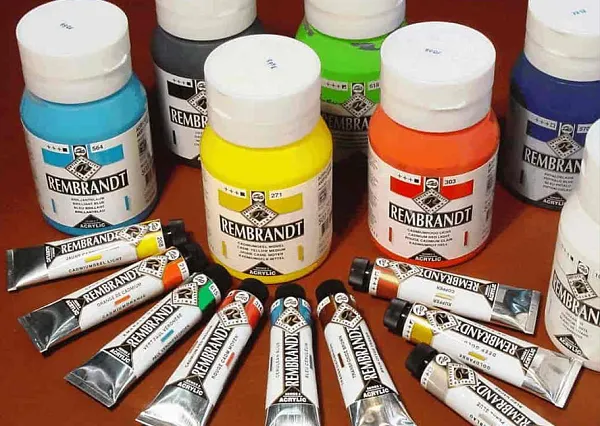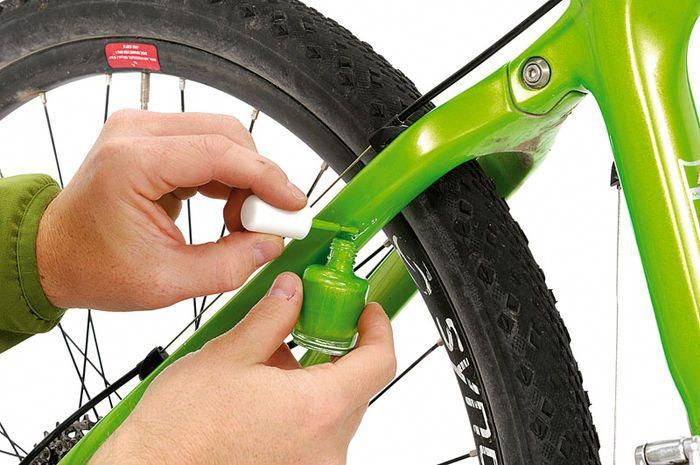Guidance
How To Fix Paint Chips On Your Bike?
Riding a bike is more than just a mode of transportation or a sporting activity; it’s a passion. However, over time, paint chips can appear, affecting the overall appearance and aesthetic of your prized possession. In this comprehensive guide, HookBike will walk you through detailed steps on how to fix paint chips on your bike, ensuring that it remains in pristine condition.
Why do bicycle frames peel off paint?
Before diving into the solutions, it’s imperative to understand the root causes behind paint chips on bikes.
Bicycle frames can experience paint peeling for a variety of reasons:
Material Expansion/Contraction: Bicycles are subjected to varying temperatures. Different materials (like metal and paint) can expand and contract at different rates, which might cause the paint to crack and eventually peel.
Impact and Abrasion: Bicycles often get bumped, hit, or scratched. This kind of wear and tear can cause paint to chip or peel. Rocks, debris, and even transportation (like mounting on a car’s bike rack) can cause abrasions to the paint.
UV Radiation: Prolonged exposure to sunlight can degrade paint over time. UV rays can cause the paint to fade and become brittle, leading to cracking and peeling.
Chemical Exposure: Exposure to certain chemicals, like those in some cleaners or solvents, can cause paint to soften, discolor, or peel.
Moisture and Corrosion: If the paint or the underlying primer is not effectively sealing the metal of the frame, moisture can get underneath. This can lead to rust (in the case of steel frames) or other forms of corrosion, causing the paint to bubble and peel.
Inferior Paint Quality: Not all paints are created equal. Some cheaper or lower-quality paints might not adhere as well or may not be as durable, leading to earlier peeling or chipping.
Flexing: Bicycles, especially mountain bikes or those used in rough terrains, can flex during use. This repeated flexing can cause the paint to crack and peel over time.
Age: Over time, even the best paint jobs can degrade. Old paint can become brittle and less adherent.
Incorrect Paint Type: Using the wrong type of paint for the material of the bicycle can lead to peeling. For example, painting a plastic component with paint designed for metal might not adhere properly.
To prevent paint from peeling, it’s crucial to ensure proper preparation of the surface, use the correct type and quality of paint, and protect the bicycle from harsh environmental conditions. Regular cleaning and maintenance can also help extend the life of the paint job.

How To Fix Paint Chips On Your Bike?
Fixing paint chips on your bike can restore its aesthetics and also offer protection against potential rusting (especially for steel frames). Here’s a step-by-step guide on how to fix paint chips on your bike:
Gathering Necessary Materials
Before you begin the repair process, ensure you have the following materials:
- Matching paint (either from the manufacturer or a closely matched alternative)
- Sandpaper (both coarse and fine-grit)
- Clear coat spray
- Primer
- Soapy water
- Soft cloth or sponge
- Masking tape
See more: How To Choose Bike Frame Materials

Steps to repaint the bicycle frame
Repainting a bicycle frame can give your bike a fresh look and protect it from elements like rust. Here’s a step-by-step guide on how to repaint your bicycle frame:
Clean the Area
- Start by cleaning the chipped area with mild soap and water to remove dirt and grease.
- Dry the area thoroughly using a clean cloth.
Sand the Area
- Use fine-grit sandpaper (e.g., 600 or 800 grit) to lightly sand the chipped area. The goal is to smooth out any raised edges and create a surface that the paint can adhere to better.
- Make sure you don’t sand too much, just enough to make the surface smooth.
Clean Again
- After sanding, wipe the area with isopropyl alcohol or a similar cleaning solvent to remove any residual dust and grease.
Apply Primer
- For larger chips or if you’re down to the bare metal, it’s a good idea to use a primer. Apply a thin coat of primer to the chipped area using a small brush or a touch-up pen.
- Let the primer dry according to the manufacturer’s recommendations.
Apply Paint
- Match the paint color of your bike. You can often find touch-up paint from the bike manufacturer or use automotive touch-up paint in a matching color.
- Using a small brush or a touch-up pen, carefully apply the paint to the chipped area. It’s better to apply thin coats and build up as needed than to apply a thick coat all at once.
- Allow each coat to dry thoroughly before applying the next.
Apply Clear Coat (Optional but recommended)
- Once the paint is dry, apply a clear coat over the area to protect the new paint and provide a glossy finish that matches the rest of the bike.
- Let the clear coat dry according to the manufacturer’s recommendations.
Buff the Area
- After the clear coat is completely dry, you can buff the area with a soft cloth and a little polishing compound to blend the repaired area with the surrounding paint. This step will make the repair less noticeable.
Maintenance
- Keep the newly painted area clean and avoid heavy abuse immediately after painting to allow the paint to cure fully.
While this process can help restore the aesthetics of your bike, achieving a perfect match in terms of color and finish can be challenging. If the chip or scratch is in a highly visible area and you’re concerned about a perfect match, consider seeking professional help or contacting the bike manufacturer for guidance.

Tips for Maintaining Your Bike’s Paintwork
Maintaining your bike’s paintwork is crucial not just for aesthetics, but also for the longevity and health of the frame, especially if it’s made of steel which can rust. Here are some tips to help maintain the paintwork:
Regular Cleaning
Wash your bike regularly, especially after rides where it gets particularly dirty. Use mild soap and water, and avoid high-pressure washers which can force water into sealed areas and remove paint.
Always rinse off mud, grime, and sweat as they can corrode or stain the paint over time.
Dry Properly
After washing, use a soft cloth to dry the bike thoroughly, focusing on areas where water might accumulate.
Use Bike-Specific Cleaners
If you’re using cleaning products, make sure they are bike-specific or, at least, safe for painted surfaces. Avoid harsh chemicals.
Protect from UV Rays
Constant exposure to sunlight can fade paint over time. Store your bike in a shaded area or indoors. If you have to keep it outdoors, consider a UV-resistant bike cover.
Apply a Bike Protectant
There are many protectant sprays available that offer a protective layer against moisture, dirt, and UV rays. They also give your bike a nice shine.
Avoid Scratches
Use caution when locking your bike to ensure the lock or chain doesn’t scratch the paint.
Be mindful when transporting your bike on a car rack or when storing multiple bikes close together.
Touch-Up Paint
If you notice small chips or scratches, touch them up sooner rather than later, especially on steel frames to prevent rust. Many manufacturers offer touch-up paint that matches the original color.
See more: what are bike frame sizes?

Use Frame Protection
Consider using frame protectors or clear adhesive patches on areas prone to chipping, like the chainstay or downtube.
For mountain bikes or those used in rugged terrains, frame protection tapes or films can prevent paint damage from rock strikes and flying debris.
Regular Inspection
Frequently inspect your frame for any signs of paint wear, rust, or damage. Addressing issues early can prevent them from worsening.
Store Properly
If storing in a garage or shed, ensure it’s dry and free from dampness. Humidity can affect the paint and lead to corrosion, especially on steel frames.
Limit Exposure to Harsh Elements:
If you’ve ridden on salted roads during winter, wash your bike soon after your ride. The salt can corrode the frame and damage the paint.
By following these tips and giving your bike regular attention, you can keep its paintwork looking fresh and vibrant for years to come.
Conclusion
A bike is a reflection of its rider’s passion and care. By understanding how to fix paint chips on your bike, you not only ensure that it looks its best, but you also increase its lifespan and functionality. With the right techniques and care, your bike will continue to shine and serve you for years to come.

